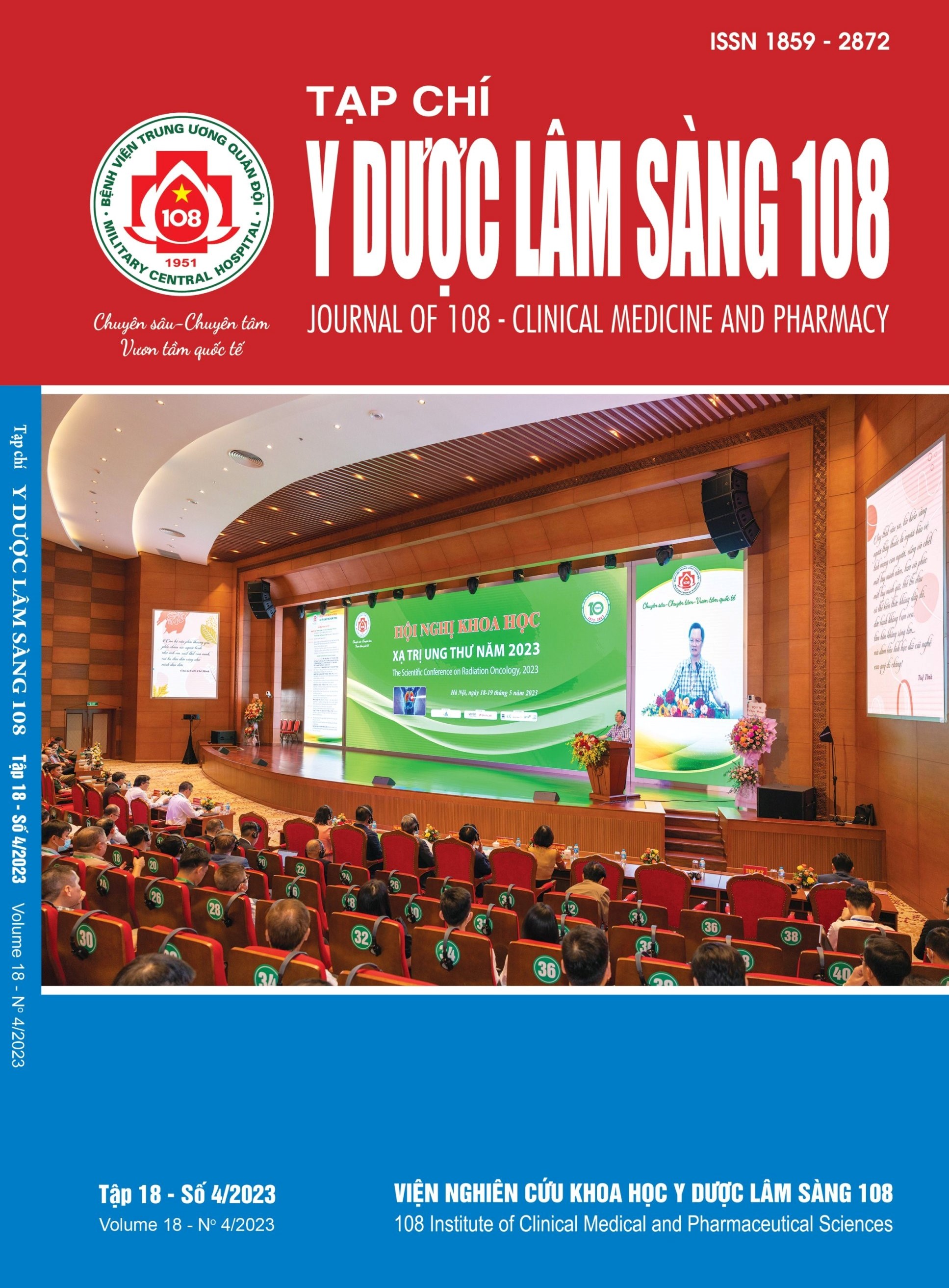Study on acute pancreatitis after endoscopic retrograde cholangiopancreatitis at 175 Military Hospital
Main Article Content
Keywords
Abstract
Objective: To determine the rate and risk factors of acute pancreatitis complications in patients after endoscopic retrograde cholangiopancreatography. Subject and method: A retrospective study on 51 patients undergoing endoscopic retrograde cholangiopancreatography at 175 Military Hospital, from January 2019 to June 2022. Clinical and subclinical symptoms were recorded before and after endoscopic retrograde cholangiopancreatography. Result: The rate of acute pancreatitis after endoscopic retrograde cholangiopancreatitis was 11.76% with acute upper abdominal pain accounting for 50.9%. Mainly, after endoscopic biliary sphincterotomy for removal of common bile duct stones, common bile duct stenting, procedure time in over 60 minutes. Serum amylase and lipase concentrations with acute pancreatitis were quite high with a median of 1041U/L and 900U/L, respectively. All patients with mild acute pancreatitis, respond well to medical treatment. Conclusion: Acute pancreatitis is a common complication after endoscopic retrograde cholangiopancreatography. The disease was diagnosed early based on abdominal pain after intervention and increased serum Amylase and Lipase concentration, most of the patients had mild acute pancreatitis.
Article Details
References
2. Nguyễn Hữu Khâm, Dương Quang Huy, Nhượng Lê Hữu (2022) Nghiên cứu đặc điểm lâm sàng và một số yếu tố liên quan đến viêm tụy cấp sau nội soi mật tụy ngược dòng lấy sỏi ống mật chủ. Tạp chí Y học Việt Nam, 518(1).
3. Nguyễn Công Long, Lục Lê Long (2022) Đánh giá kết quả phương pháp nội soi mật tụy ngược dòng ở bệnh nhân sỏi ống mật chủ tại Bệnh viện Bạch Mai. Tạp chí Y học Việt Nam 513(1).
4. Artifon EL, Chu A, Freeman M, Sakai P, Usmani A, Kumar A (2010) A comparison of the consensus and clinical definitions of pancreatitis with a proposal to redefine post-endoscopic retrograde cholangiopancreatography pancreatitis. Pancreas, 39(4): 530-535.
5. Banks PA, Bollen TL, Dervenis C, Gooszen HG, Johnson CD, Sarr MG, Tsiotos GG, Vege SS; Acute Pancreatitis Classification Working Group (2013) Classification of acute pancreatitis 2012: Revision of the Atlanta classification and definitions by international consensus. Gut 62(1): 102.
6. Cheng CL, Sherman S, Watkins JL, Barnett J, Freeman M, Geenen J, Ryan M, Parker H, Frakes JT, Fogel EL, Silverman WB, Dua KS, Aliperti G, Yakshe P, Uzer M, Jones W, Goff J, Lazzell-Pannell L, Rashdan A, Temkit M, Lehman GA (2006) Risk factors for post-ERCP pancreatitis: A prospective multicenter study. Am J Gastroenterol 101(1): 139-147.
7. Cotton PB, Lehman G, Vennes J, Geenen JE, Russell RC, Meyers WC, Liguory C, Nickl N (1991) Endoscopic sphincterotomy complications and their management: An attempt at consensus. Gastrointest Endosc 37(3): 383-393.
8. Dumonceau JM, Andriulli A, Elmunzer BJ, Mariani A, Meister T, Deviere J, Marek T, Baron TH, Hassan C, Testoni PA, Kapral C (2010) European Society of Gastrointestinal Endoscopy (ESGE) Guideline: prophylaxis of post-ERCP pancreatitis. Endoscopy 42(6): 503-515.
9. He QB, Xu T, Wang J, Li YH, Wang L, Zou XP (2015) Risk factors for post-ERCP pancreatitis and hyperamylasemia: A retrospective single-center study. J Dig Dis 16(8): 471-478.
10. Iorgulescu A, Sandu I, Turcu F, Iordache N (2013) Post-ERCP acute pancreatitis and its risk factors. J Med Life 6(1): 109-113.
11. Tadehara M et al (2019) Usefulness of serum lipase for early diagnosis of post-endoscopic retrograde cholangiopancreatography pancreatitis. World J Gastrointest Endosc 11(9): 477-485.
12. Uchino Rie et al (2014) Detection of painless pancreatitis by computed tomography in patients with post-endoscopic retrograde cholangiopancreatography hyperamylasemia. 14(1): 17-20.
 ISSN: 1859 - 2872
ISSN: 1859 - 2872
